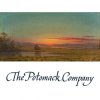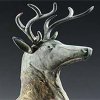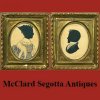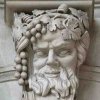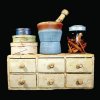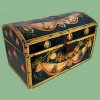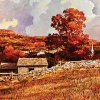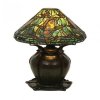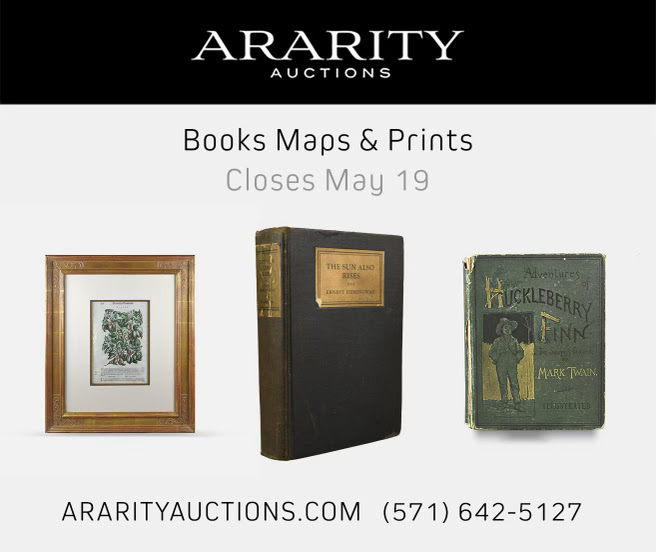Tremont Auctions, Sudbury, Massachusetts
Photos courtesy Tremont Auctions
Winfield Robbins (1841-1910) of Arlington, Massachusetts, scion of a local family of major benefactors of the town, was also an inveterate collector. A benefactor himself and with foresight, he traveled widely and collected important prints, fearing that the advent of photography would render them obsolete. He left money to build the town hall in memory of his father, Amos Robbins, and bequeathed his collection of prints to the library, which was built to honor his uncle Eli Robbins. According to the Robbins Library website, the original bequest was 150,000 prints. Winfield Robbins’s surviving cousins managed the design and construction of the building along with a memorial garden to him, the centerpiece of which was The Menotomy Hunter by Cyrus E. Dallin (1861-1944), who was born in Utah but lived and worked in Arlington for many years.
More than a century after Robbins’s bequest, the library, which is home to the longest continuously operating children’s library in the U.S., was running short of space, and Tremont Auctions was called in to sell the collection.
Tremont staff worked their way through the collection, and on February 25 Tremont Auctions offered over 220 lots of old master prints and drawings from the Winfield Robbins collection in the Sudbury auction gallery. Multiple images of many prints were sold. Because Winfield Robbins stored his collection carefully, most pieces were in amazing condition, not having been exposed to light and handling. Eight lots of 19th-century Japanese prints that retained their original brilliant colors were offered early in the auction. The top lot of the Japanese prints was a series of woodblock prints by Edo-born Tsukioka Yoshitoshi (1839-1892), “New Forms of 36 Ghosts,” that sold for $19,520 (including buyer’s premium). The top lot overall was a 1710 mezzotint portrait by John Faber the Elder (1660-1721), On Nee Yeath Tow no Riow. King of Granajah Hore vulgo King John, that sold for $35,380 (est. $2000/3000).
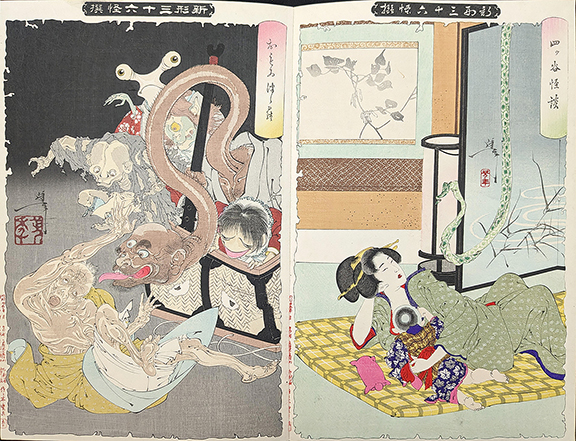
Considered the last great practitioner of ukiyo-e, Edo-born Tsukioka Yoshitoshi (1839-1892) created woodblock prints and series depicting ghost stories, folk tales, battles, the moon, and much more. A 14" x 9½" album with silk brocade covers holding the series “New Forms of 36 Ghosts,” including 36 woodblock prints (two shown), the title/contents page, and the publisher’s imperial commendation page, sold for $19,520 (est. $5000/7000).
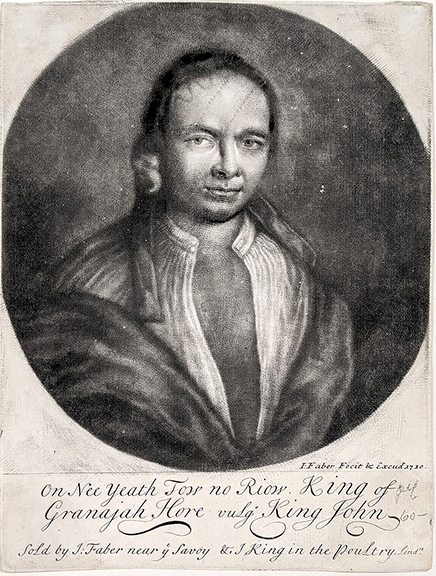
The original 1710 mezzotint portrait On Nee Yeath Tow no Riow. King of Granajah Hore vulgo King John was by John Faber the Elder (1660-1721). This 18" x 14" print sold for $35,380 (est. $2000/3000). It depicts Native American chief King John of Canajoharie, one of three Iroquois chiefs who traveled to England in 1710 to meet Queen Anne, hoping to gain British support in their conflict with the French. He gained the name John when he was baptized.
The live bidding audience was sparse, with staff far outnumbering the seven in-house bidders, but as many as 100 online viewers per lot were observed. For more information, visit the website (www.tremontauctions.com) or call (617) 795-1678.
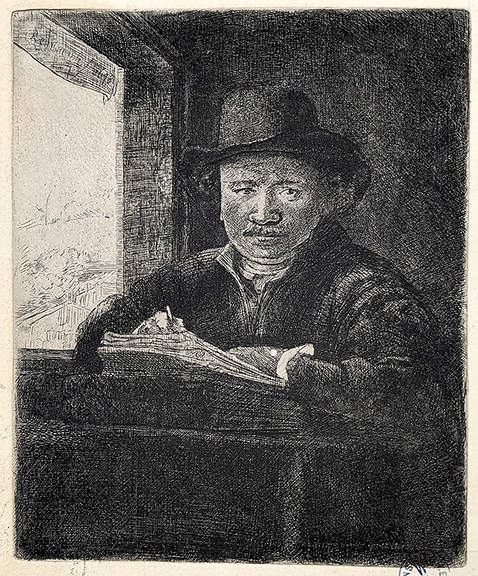
Two self-portraits by Rembrandt van Rijn (1606-1669) were sold. This one, Self-Portrait Etching at a Window (New Hollstein 240), was made in 1648 on thick yellowish laid paper. With no visible watermark but with Winfield Robbins’s collection stamp, the image sold for $1220 (est. $500/1000). Compared to the self-portrait in the flat cap (right), which was made several years earlier, this image is much more detailed and contained.
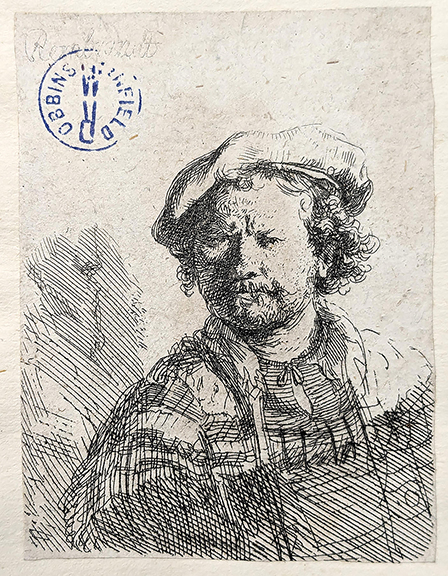
Rembrandt’s Self-portrait in a Flat Cap and Embroidered Dress (New Hollstein 210), 10¼" x 8¼" overall, circa 1642, bears no visible watermark but carries Winfield Robbins’s collection stamp. It is laid down completely on the backing sheet. With an estimate of $500/1000, the image sold for $2928.
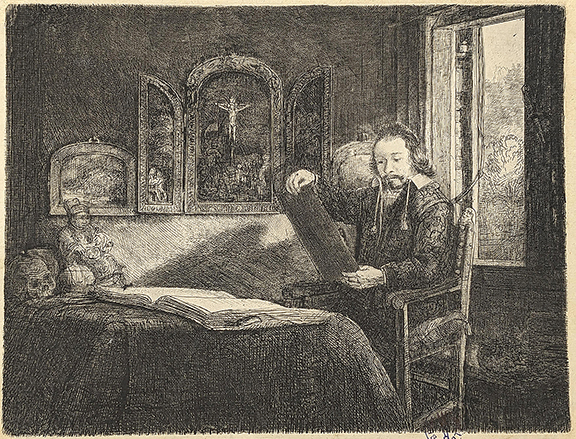
Rembrandt van Rijn made Apothecary (New Hollstein 301), a print depicting his close friend Abraham Francen (1612-after 1678), around 1657. Francen, who was also a collector, is pictured with books, paintings, a triptych of the crucifixion, a skull, a print or drawing in his hands, and a book of prints on the table in front of him. The print, 6¾" x 8½" overall, has no watermark but sold for $1586 (est. $500/1000).
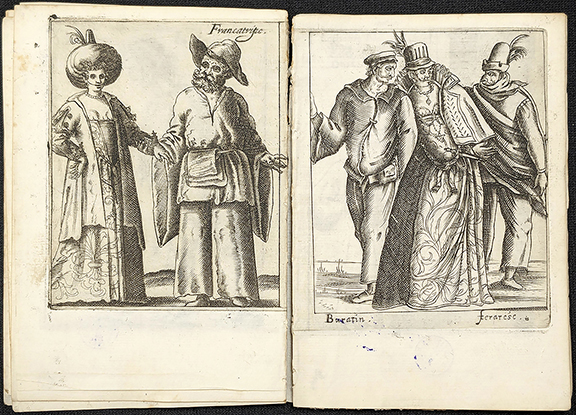
A series of 25 plates (two shown) engraved and published in 1642 by Francesco Bertelli of Padua (active first half of the 17th century) depicts masked and costumed figures for the Venice Carnival. The series includes 22 engraved plates, one engraved title page/frontispiece, and two fold-out plates depicting processions. One of the foldouts was attached to another group of 34 plates depicting carnival events and landmarks. The lot was estimated at $2000/3000 and brought $5124.
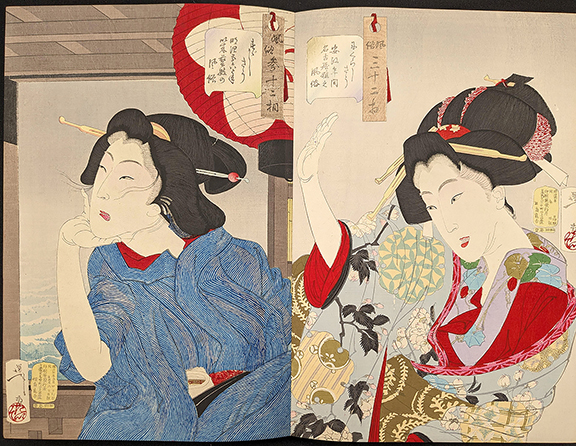
The ukiyo-e series titled “Fuzoku Sanjuniso” (“32 Aspects of Customs and Manners of Women”)was made by Tsukioka Yoshitoshi late in his career. The 14" x 9½" album of 32 Japanese woodblock prints (two shown) with the publisher’s imperial commendation page brought $15,860 (est. $2000/3000).

These views of London before and after the 1666 fire were made in 1666 by artist Wenceslaus Hollar (1607-1677). Born in Prague, Hollar worked in several towns in Germany. By 1636 he had arrived in London for the first time, and he spent much of his life in England. The etching, 220 mm x 683 mm (approximately 8 2/3" x 26¾", is on two joined papers with a watermark. It sold for $3172 (est. $2000/3000).
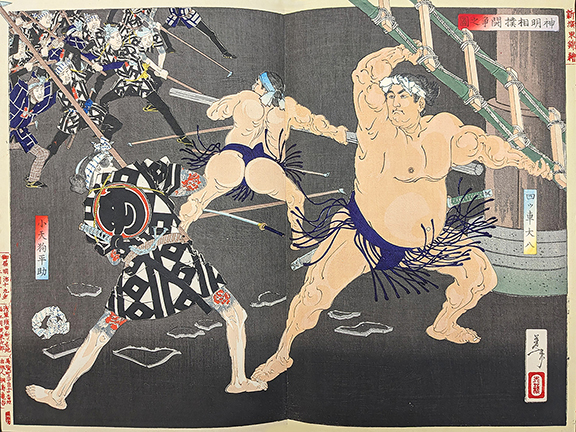
Tsukioka Yoshitoshi’s “New Selection of Eastern Brocade Pictures” includes 19 Japanese woodblock diptychs (38 sheets) of various scenes (one shown), in a 14" x 9½" album with silk brocade covers. With the prints still in strong colors, the album sold for $9150 (est. $2000/3000).
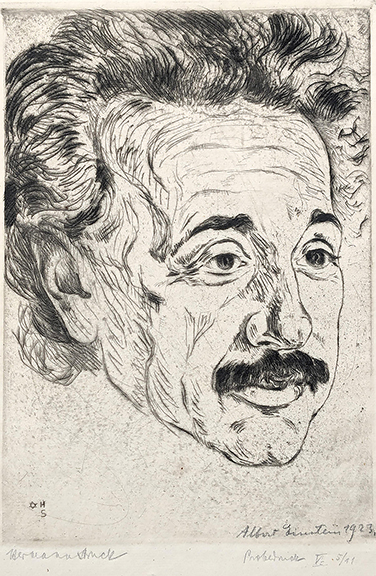
This engraved portrait of Albert Einstein (1879-1955) by Hermann Struck (1876-1944), 207 mm x 147 mm (approximately 8¼" x 5¾"), was made around 1920 and is signed in pencil and dated 1923 by Einstein. Struck signed it and identified it as an artist’s proof, “Probedruck V 5/11,” and signed it in the plate with his initials and a Star of David. Estimated at $4000/6000, it brought $5612.
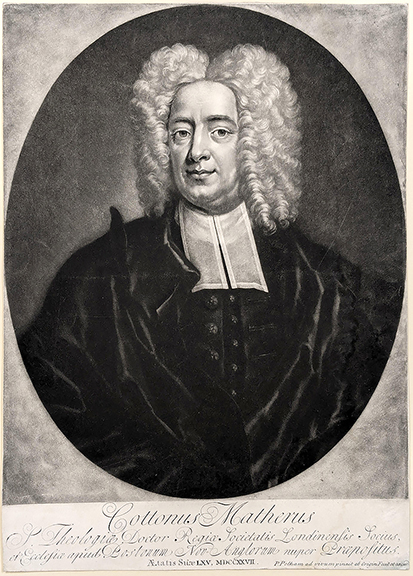
The first mezzotint printed in America was this 1727 portrait by Peter Pelham (c. 1697-1751) of the fiery Puritan minister Cotton Mather (1663-1728), Cottonus Matheris S. Theologia Doctor Regia Societas Londinensis Locius, et Ecclesia apud Bostonum Nov Anglorum nuper Prapositus, 13¾" x 9¾", which sold for $5124 (est. $400/600).
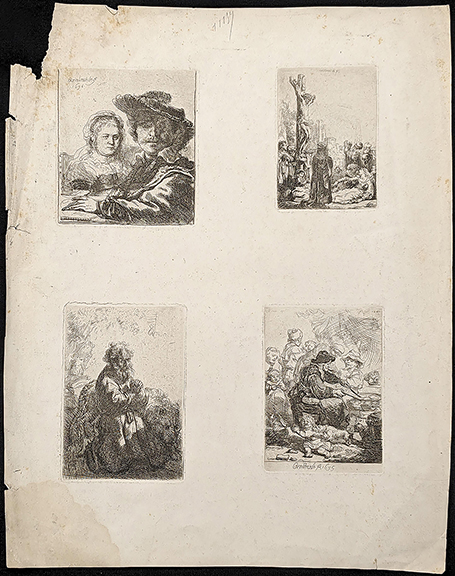
Four Rembrandt van Rijn etchings printed on a single sheet of medium-weight off-white wove paper, 14½" x 11½", sold for $4636 (est. $500/1000). Each is included in the New Hollstein catalogue raisonné. They are Self-portrait with Saskia,1636; The Crucifixion,small plate, circa 1635; St. Jerome Kneeling in Prayer, Looking Down, 1635; and The Pancake Woman,1635. Some 90 people were viewing the lot online, while seven bidders watched in the salesroom, outnumbered considerably by staff.
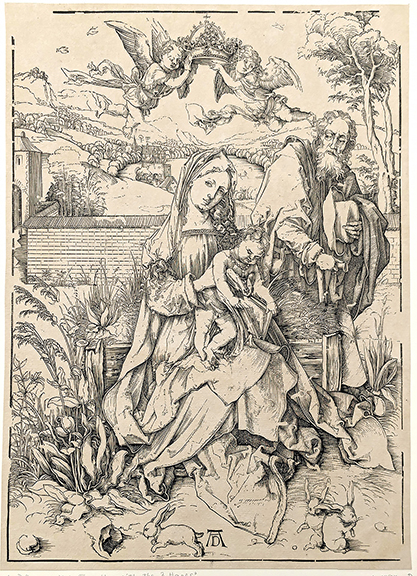
German artist Albrecht Dürer (1471-1528) made this woodcut, The Holy Family with Three Hares, 24" x 19", around 1498. It was published on thick cream laid paper with a large spread-eagle watermark. With an estimate of $200/300, it brought $3660.
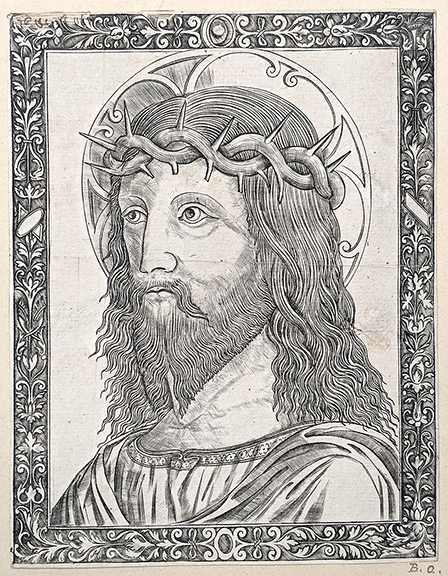
A lot of old master prints from the 16th through the 18th centuries included this print, The Head of Christ (possibly early 16th century), which bears the initials “T.R.” in the upper left border and “B.O.” in the lower right margin. The lot also included works after Rembrandt, a portrait of Henry, Duke of Montmorency, a self-portrait by Georg Friedrich Schmidt, Fall and Sobreitas by Hieronymus Cock, and Hercules and Omphale by Bartolomeus Dolendo, among others. Estimated at $300/500, the lot realized $3416.
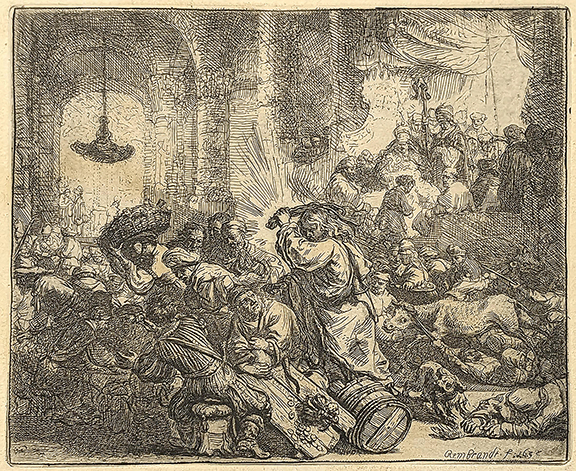
Rembrandt’s Christ Driving the Moneychangers from the Temple (New Hollstein 139, II/IV), 8" x 10¼", on medium-weight tan laid paper, has some staining and a fragment watermark of a coat of arms. It sold for $3660 (est. $500/1000).
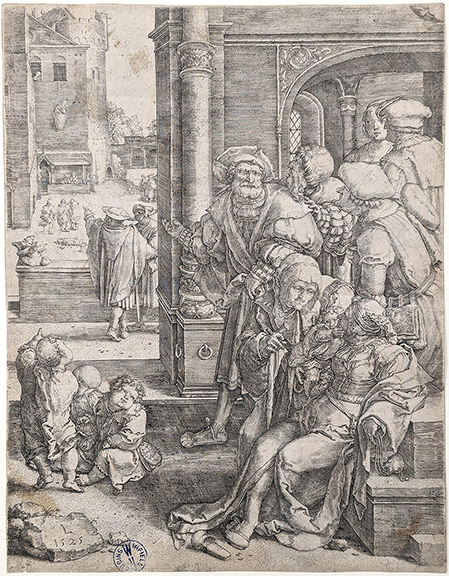
Ten works by Dutch painter and maker of engravings and woodcuts Lucas van Leyden (1489/94-1533) included The Poet Virgil Suspended in a Basket (shown, 18" x 14"), Prudence,and Woman Picking Fleas from a Dog. The suspension of Virgil refers to the poet’s having fallen in love with the emperor’s daughter, who instructed him to ascend to her bedroom in a basket; he did, and she left him hanging there, subject to the ridicule of all and sundry. In Woman Picking Fleas, the woman is naked. Estimated at $200/300, the lot brought $2318.
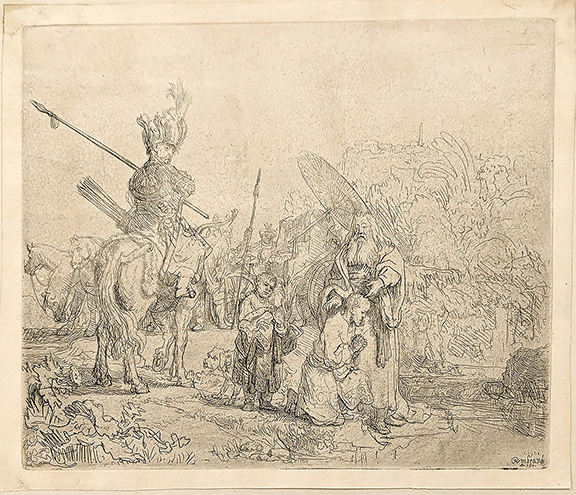
The Baptism of the Eunuch (New Hollstein 186),a print by Rembrandt, 1641, 11¾" x 16¾", on thin cream wove paper with no visible watermark is only partially mounted. Estimated at $500/1000, it brought $2318.
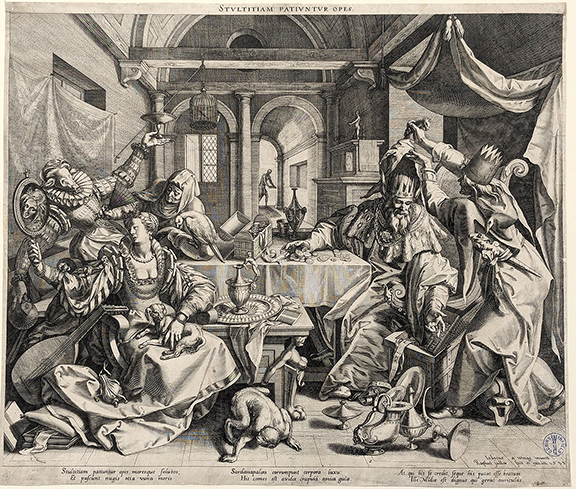
A lot of ten 14" x 18" prints consisted of four images by Flemish engraver Raphael Sadeler (1560/61-1628/32), including this print, Stultitiam Patiuntur Opes (Wealth Permits Stupidity), and Supper at Emmaus, Expulsion from the Garden of Eden by Dutch artist Jan Pieterszoon Saenredam (1565-1607), and others. The lot was estimated at $200/300 and elicited $4148.
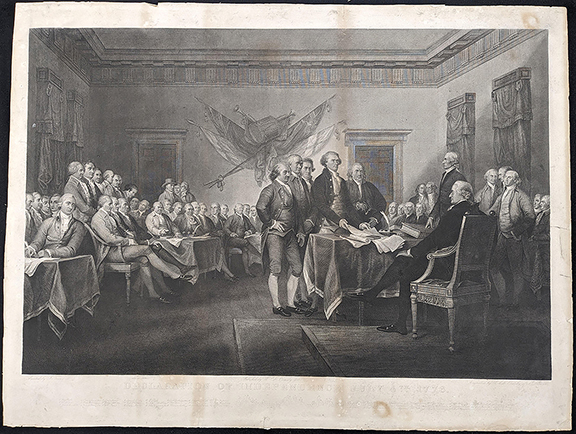
Five 19th-century prints of events of the American Revolution included two examples (one shown) of the Declaration of Independence, July 4th 1776, 24" x 32"; The Death of General Montgomery, the English and French version published in 1808 by John Trumbull; Franklin Before the Lords in Council 1774, published by Thomas Kelly; and The Path to Liberty: Death of Gen. Montgomery Dec. 31 1775. The group was estimated at $200/300, and it sold for $3904.
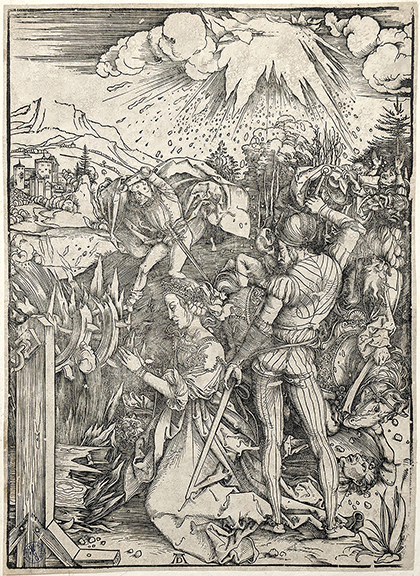
The Martyrdom of St. Catherine (Hollstein 236, Meder 236), a woodcut by Albrecht Dürer, 15¾" x 11¼", was made around 1496-97 on stiff gray medium-weight paper with a Gothic “P” watermark. It realized $3660 (est. $300/500).
Originally published in the May 2024 issue of Maine Antique Digest. © 2024 Maine Antique Digest





